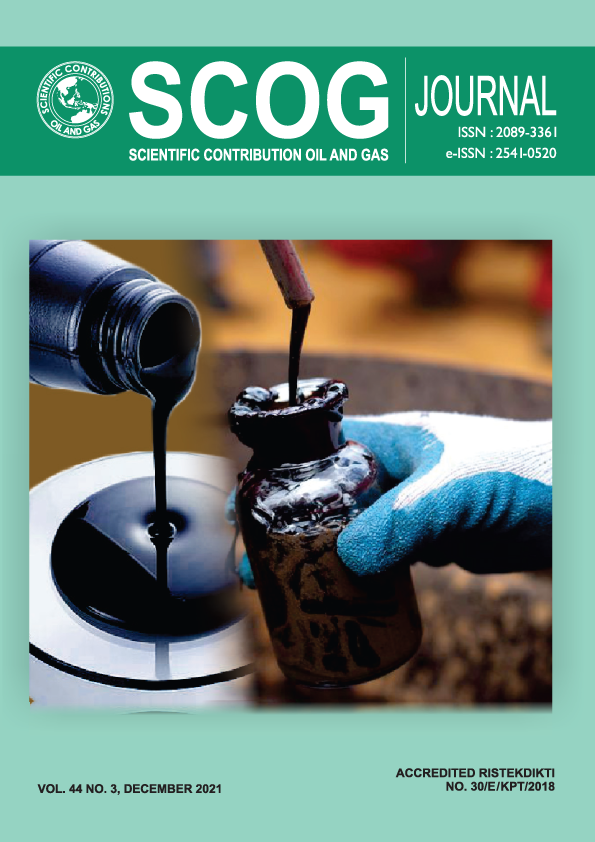Geochemical Properties of Heavy Oil in Central Sumatra Basin
DOI:
https://doi.org/10.29017/SCOG.44.3.710Keywords:
Heavy oil, gas chromatogaphy, Central Sumatera BasinAbstract
Heavyoilcommonly occurs due to biodegradation, whichmade the lighter fractiondisappears and then leaves the heavier fraction. Heavy oil is characterized by asphaltic, solid, and viscous because it contains asphalthene. Chemically, heavy oils contain fewer hydrogen atoms than light oils. Bulk properties ofheavy oil in addition to having a specific gravity of less than 25° API gravity, high viscosity, and often contain (concentration) of heavy metals (vanadium, nickel) which is higher than light oil (normal oil). Geochemical analysis based on the gas chromatography (GC) chromatogram of heavy oil in the Central Sumatra Basin shows a different pattern. The chromatogram pattern eliminates the light molecular fractions of the compounds in biodegraded oil and tar sand/bitumen. According to their geochemical properties, there are 4 (four) types of heavy oil in the Central Sumatra Basin namely: Type l come from shallow reservoir, water wash, and full biodegradation/all alkane depleted); Type 2 come from shallow reservoir, meteoric water, and light biodegradation, only low molecular weight alkane depleted); Type 3 come from deep reservoir, vertical gravity segregation, decreased weight fraction, can be caused by oil conditions in thick reservoirs, covered by impermeable lithology and usually located on the edge of the field (flank). Type 4 which contains medium-heavy oil (27°API) and is difficult to produce.
References
Head, I. M., Jones, D. M. & Larter, S. R., 2003. Biological activity in the deep subsurface and the origin of heavy oil. Nature, Volume 426, p. 344-352.
Huang, W.-Y. & Meinschein, W. G., 1979. Sterols as ecological indicators. Geochimica et Cosmochimica Acta, 43(5), pp. 739-745.
LEMIGAS, 2020. Kajian Potensi Minyak Berat (Oil Sands) dan Bitumen di Cekungan Sumatera Tengah (Study on Heavy Oil Potential of Central Sumatra Basin)- Unpublished Final Report, Jakarta: PPPTMGB "LEMIGAS", Research &Development Agency.
Meyer, R. F., Attanasi, E. D. & Freeman, P. A., 2007. Heavy Oil and Natural Bitumen Resources in Geological Basins of the World, Reston, Virginia: United State Geological Survey (USGS).
Miiller, D. E., Holba, A. G. & Hughes, W. B., 1987. Effects of Biodegradation on Crude Oils. In: R. F. Meyer, ed. Exploration for Heavy Crude Oil and Natural Bitumen:American Association of Petroleum Geologists, p. 731.
Peters, K. E., Walters, C. C. & Moldowan, J. M., 2005. The Biomarker Guide, Biomarker and Isotopes in Petroleum Exploration and Earth History. Cambridge: Cambridge University Press.
Wenger, L. M., Davis, C. L. & Isaksen, G. H., 2002. Multiple Controls on Petroleum Biodegradation and Impact on Oil Quality. SPE Reservoir Evaluation & Engineering, 5(05), pp. 375-383.
Downloads
Published
Issue
Section
License
Copyright (c) 2022 SCIENTIFIC CONTRIBUTIONS OIL AND GAS (SCOG)

This work is licensed under a Creative Commons Attribution 4.0 International License.
Authors are free to Share — copy and redistribute the material in any medium or format for any purpose, even commercially Adapt — remix, transform, and build upon the material for any purpose, even commercially.
The licensor cannot revoke these freedoms as long as you follow the license terms, under the following terms Attribution — You must give appropriate credit , provide a link to the license, and indicate if changes were made . You may do so in any reasonable manner, but not in any way that suggests the licensor endorses you or your use.
No additional restrictions — You may not apply legal terms or technological measures that legally restrict others from doing anything the license permits.














